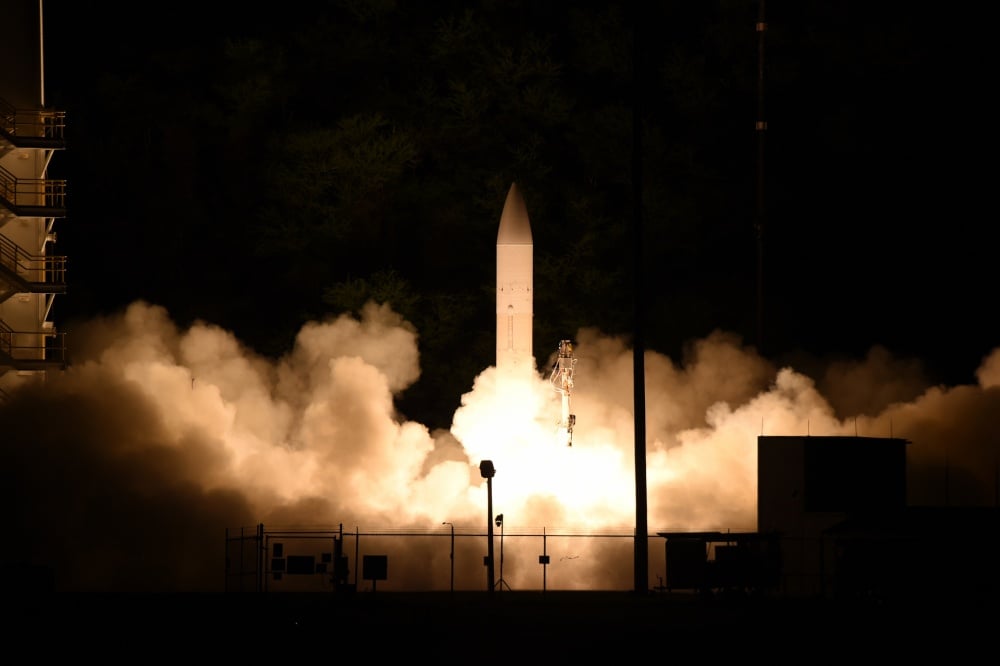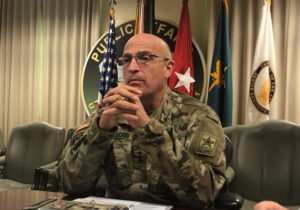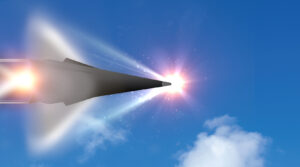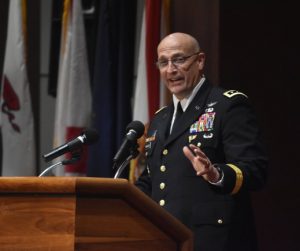
Launch of Army-Navy Common-Hypersonic Glide Body (C-HGB) in Hawaii on March 19, 2020.
WASHINGTON: “We need to accelerate the pace of testing,” the Army’s three-star director of hypersonics says. “Fourth quarter FY23 is when the Army builds [this weapon]; that time is coming really fast. [And] we’re lucky, because when we woke up on the 27th of December and the Russians publicly declared that they had fielded a similar capability, that really put us on a path to accelerate.”

Lt. Gen. Neil Thurgood
Last year, Lt. Gen. Neil Thurgood took over the Army’s reorganized and renamed Rapid Capabilities and Critical Technologies Office (RCCTO), which is now responsible for both offensive hypersonic missiles and missile defense lasers. What kind of acceleration is he talking about?
The weapon that evolved into the Common Hypersonic Glide Body – so-called because it will go on both Army land-launched missiles and Navy submarine-launched ones – has had just four flight tests in nine years. The first, successful flight was in 2011. It took three years to get to the second test, in 2014, which produced no useful data because the booster rocket failed and the glide body never detached. The second successful test took another three years, to 2017; the third test, last month, another three years.
But looking forward, “our next flight test will be in third quarter ’21. Then we have additional flight tests in first quarter ’22,” Thurgood told me. “We have five more flight tests – at least five more flight tests – before we build in fourth quarter ’23.”
Tests will not only come closer together. They’ll also become more demanding.
“We are working to make it more accurate and survive in a more stressful environment,” said Thurgood’s deputy for hypersonics, Robert Strider. “With every test that we do, we’re increasing the test envelope to make sure that it will work as designed.”

Sandia National Laboratories glide vehicle, the ancestor of the Army-built Common Hypersonic Glide Body
That initial test in 2011 – using a larger and less refined version of the glide body – was simply about proving the design could survive the flight profile: extreme acceleration from the booster, the heat of air friction as it ripped through the atmosphere, the vacuum of near space, and reentry coming down. The failed 2014 test, and the 2017 test that replaced it, began to explore accuracy, lethality, and other performance characteristics. The future tests focus on fine-tuning the design to perform precisely as the Army and Navy missions require.
“As we hone in further and further on refining our operational outcomes, the [test] objectives become more narrow in their scope,” Thurgood told me. “We know over the next five tests exactly the outcomes we need to test to.”
In parallel to the flight test program, the Army is also trying to build an industrial base from scratch. All the glide bodies tested so far have been built, one at a time, at the Energy Department’s Sandia National Laboratories, which invented the design. That’s not a viable model for mass production.
“The glide body technology is solely owned by the government,” Thurgood told me. “They’re currently produced – ‘made’ is probably a better word. It’s not really a production line – they’re really handmade by the great folks out at Sandia. [But] obviously how the great PhDs at Sandia make a thing may not be how we commercially make a thing.”
So the Army has contracted aerospace firm Dynetics – whose subcontractors include major players like Lockheed Martin, Raytheon, and General Atomics – to start a private-sector manufacturing line. The companies have teams at Sandia learning how to build the design first-hand from its inventors. Over time, Dynetics & co. will take the lead. First they’ll build a glide body at Sandia under the lab scientists’ supervision. Then, about a year from now, Dynetics will start production at their Huntsville, Ala. factory.

Dynetics concept for their Common Hypersonic Glide Body (C-HGB)
Can the Army and its contractors stick to this tight schedule amidst the disruptions of COVID-19? “Right now, I think it’s exactly on track where it needs to be,” Thurgood told me. “Even in this (COVID-19) crisis we have now, our industry partners are responding really well.” By working from home where possible, and breaking up large groups of workers into small ones where hands-on labor is required, the program has so far kept going despite the pandemic.
The other potential disruption is the Air Force’s withdrawal from the Common Hypersonic Glide Body program to focus on other, more compact hypersonic weapons that fit better on an aircraft. Even when they were involved, Thurgood told me, their unique requirements required some modifications to the glide body before they could use it. Looking forward, he said, there’s also a possibility the Air Force might step back in.
With the Air Force no longer paying a share of the overhead, “it’ll change our cost numbers a little bit,” Thurgood acknowledged. But it also frees up R&D resources for the Army and Navy.
The Air Force continues to participate in the all-service board of directors governing the Common Hypersonics Glide Body project, he said.
The current membership:
- Thurgood, director of the Rapid Capabilities & Critical Technologies Office (RCCTO), US Army
- Vice Adm. Johnny Wolfe, director of Strategic Systems Programs (SSP), US Navy
- Lt. Gen. Duke Richardson, military deputy to the assistant Air Force secretary for acquisition, technology, and logistics
- Vice Adm. Jon Hill, director of the Missile Defense Agency (MDA)
- Mike White, Assistant Director for Hypersonics for the Undersecretary of Defense, Research & Engineering
- Kevin Fahey, Assistant Secretary of Defense for Acquisition
For more from our interview with Lt. Gen. Thurgood, read the edited transcript below:
Q: How does the division of labor among the services work?

Army Lt. Gen. Neil Thurgood
A: It’s a really great relationship we have with Admiral Wolfe in the partnership we have with the Navy. We have a Memorandum Of Agreement: the Navy owns the design responsibilities for all the services, the Army owns the production responsibilities for the glide bodies for all the services.
The Air Force has always been an important partner in this program, but they were mostly a receiver of the technologies. Now the Air Force has terminated their HCSW [Hypersonic Conventional Strike Weapon] program, which shared the same common hypersonic glide body.
Some of the investments they had in their program, we’ve agreed as a glide body board of directors to redistribute some of that into the Army and Navy, because they had resources that we can now leverage, like software integration labs and hardware integration labs.
They’re still members of the board. They still come to our meetings as a partner. We’re still happy to have them, and there still may be an opportunity in the future for that piece of the Air Force technology to be regenerated. We’re keeping them in the loop as we go forward.
Q: How are you working with industry?
A: We don’t have a big single prime just doing everything for us. There’s about six companies that are the key players in this, with a large number of subs. We’ve formed a partnership called the Industrial Board of Directors in order to be transparent and engage with our industry partners.
We have a quarterly meeting. We share our literature. We share our cost data. We share schedule data across all these companies totally transparently.
We have signed a contract with a company called Dynetics to become the commercial producer of the glide bodies, but it’s one thing to have the technical data package on how to build a thing: It’s another thing actually to build it. if you’re anything like me, the first time you built a baby crib, you had a couple of bolts left over. There’s a learning curve that’s associated with that and we want them to learn that from experts, which is Sandia.
Dynetics and their subcontractors, including Lockheed, Raytheon, and General Atomics, they’re all out at Sandia in teams. We just finished our second class, actually. They have been helping build the glide bodies that we’re using.
They’ll actually build their first glide body out at Sandia. Then they’ll transition to Huntsville.
Q: How are both the government and industry sides coping with COVID-19?
A: As tragic as it is, we’ve been able to keep ourselves on track and minimize the impact.
We’re maximizing our telework in the government and with our industry partners as much as we can. We haven’t changed any of our battle rhythm meetings, our review processes. We don’t do it in person anymore. We do it on VTC and our online tools.
If you’re a software engineer, you can actually do that work in an alternate work location. You don’t actually have to be at your office. Same with some engineering work. They’re really being quite creative and innovative in how they’re keeping themselves on track.
Our industry partners, some of this is touch labor, meaning they’ve got to bend metal and they got to put bolts in things. They’ve been able to make smaller groups and different shifts. You can have smaller groups come in at variable times throughout the day rather than a single shift when everybody’s there at one time in the day.
Q: How has the program progressed through flight tests, and what’s the plan going forward?
A: 2011 was really the first hypersonic flight test; that was done by the great S&T community in conjunction with Sandia, who owns the design. It was really to see if the materials, the technology we had would survive the environment we needed to survive.
That was followed by another successful test in 2017 with some refinements to the glide body. And then this test we just had last week had some additional refinements. Now we’re really making tweaks to the insides of the glide body and how we execute the missions.
I won’t give any specific numbers, but the original glide body was a little bit bigger when we were testing in 2011. Now the glide body is the size that we’re going to build. There are nuances of the changes in the material technologies, certainly the technologies that are on the inside, that you’re not going to be able to tell by looking at it
If you look at the 2011 test, it was really to see if the materials, the technology we had would survive the environment we needed to. Once you proved that in 2011, then in 2014 you would start envelope expansion, you start accuracy expansion, lethality expansion.
Now unfortunately, as you mentioned, the 2014 test, the booster was fouled on takeoff and the glide body never actually separated from the booster. In the 2017 test, we had to replan some of the things in ’14 that didn’t work out.
Our next flight test will be in third quarter ’21. Then we have additional flight tests in first quarter ’22. OSD [the Office of the Secretary of Defense] has the lead to make sure that our test infrastructure can support what we need. There’s a lot of work going on what the range complexes need to adjust to.
As we accelerate our tests, we’ll actually be able to train the future workforce at a faster pace than we have. The young engineers are in ops all the time.
Sullivan: Defense industry ‘still underestimating’ global need for munitions
National Security Advisor Jake Sullivan said that there are “no plans” for another Ukraine supplemental at this point.


























